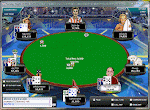When we are playing cards, we need to constantly be aware of how our table image evolves as we play and make adjustments accordingly. Happy Donkey was playing last night at the $1/$2 NL game at Santa Fe Station and the following two hands provide an excellent example of that concept:
The first hand Happy Donkey made a fabulous bluff on the turn. The cut off had opened the betting pre-flop with a raise, which HD called from the BB with Q 10. The flop came nine high with two clubs. HD checked and the cutoff made a rather standard continuation bet of $25. HD called this bet with the express purpose (as I later found out) of putting in a bluff on the turn. The turn came an ace of clubs and HD bet out $75. The cut off thought only briefly before disgustingly mucking pocket Kings face up. Happy Donkey then turned over his Queen high (with no club) bluff and scooped the pot. It was a great play and a wonderful bluff, but on the very next hand, HD made a mistake by not realizing what showing a bluff like that would do to his table image.
On the very next hand, HD was dealt 3 4 clubs in the SB and called into an unraised pot pre-flop. The flop came 2 2 K two clubs and HD led out with a pot sized bet of $15. He was min-raised to $30 by a player in middle position and the rest of the table folded. A blank came off on the turn and when HD checked, the other player bet the pot for $75. Happy Donkey had to lay down his flush draw.
We later talked about this play and went over the various reasons why one would want to bet out with a flush draw. Certainly, when the board is paired (as it was) on the flop, leading out with the flush draw can be a good play because it is very difficult for anyone without a deuce to call you. Even Kings with medium to bad kickers will usually lay it down in that situation. So betting out the flush draw, rather than calling, gives you an extra way to win the pot. HOWEVER, because HD had just showed a big bluff the hand before, it was extremely unlikely that he was going to receive much credit for his bet on the flop. This would have made betting out brilliant had he actually had the deuce, but since he only had a draw, betting out after showing the bluff just made it much more likely that his bet would be raised. He would have been better, had he considered his current table image, to check/call the draw. Had he done so, the bet on the flop would have been smaller, there might have been more callers, and he might have ended up having the odds to call for his flush again on the turn. Instead, he had to lay it down.
Until next time...remember... your table image suffers dramatically if you wear shades at games with buy-ins under $1000!
Sunday, November 4, 2007
Subscribe to:
Post Comments (Atom)




No comments:
Post a Comment